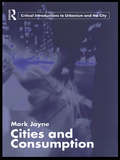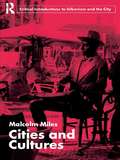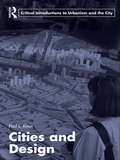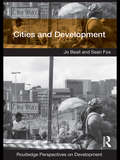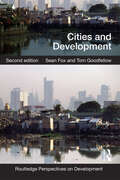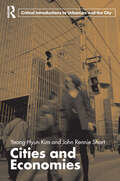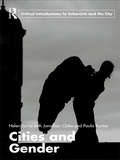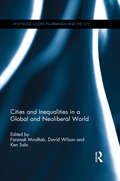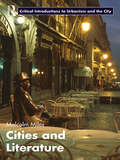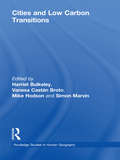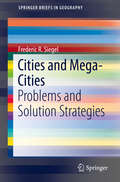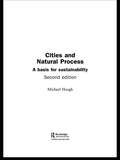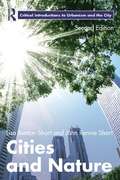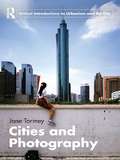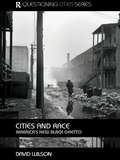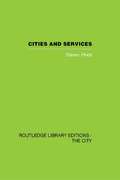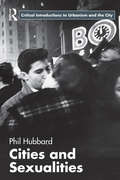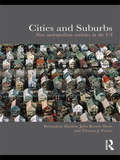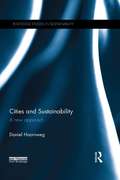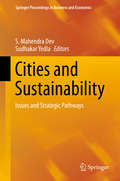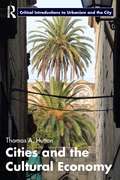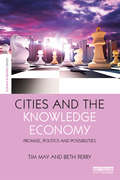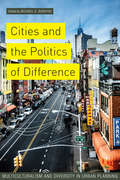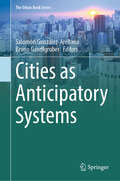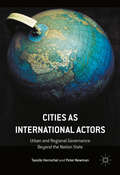- Table View
- List View
Cities and Consumption (Routledge Critical Introductions to Urbanism and the City)
by Mark JayneIn investigating the mutual and dynamic relationship between urban development and consumption, this book asks: how are cities moulded by consumption, and how is consumption moulded by cities? Consumption stands at the intersection of different spheres of everyday life: between the public and the private, the political and the personal, the individual and the social. It is considered to be a means and motor of social change; as an active ingredient in the construction of space and place, and in constructing subjectivity and social selfhood. Providing a critical review of the ways in which urban development has been conceptualized, this book critiques urban regeneration initiatives, examines ordinary and spectacular consumption, and describes the relationship between consumption and development of the modern and post-modern city. It investigates: consumption and the city consumption and everyday life consumption, cities and identity consumption and urban regeneration. Consumption is understood to have multiple roles as a political, economic and cultural touchstone, and to be an active ingredient in the construction of place and space. Using international case studies and illustrations throughout, this book thoroughly analyzes consumption and the city, and provides a useful text for students of urban studies, sociology and geography.
Cities and Cultures
by Malcolm MilesCities and Cultures is a critical account of the relations between contemporary cities and the cultures they produce and which in turn shape them. The book questions received ideas of what constitutes a city's culture through case studies in which different kinds of culture - the arts, cultural institutions and heritage, distinctive ways of life - are seen to be differently used in or affected by the development of particular cities. The book does not mask the complexity of this, but explains it in ways accessible for undergraduates. The book begins with introductory chapters on the concepts of a city and a culture (the latter in the anthropological sense as well as denoting the arts), citing cases from modern literature. The book then moves from a critical account of cultural production in a metropolitan setting to the idea that a city, too, is produced through the characteristic ways of life of its inhabitants. The cultural industries are scrutinised for their relation to such cultures as well as to city marketing, and attention is given to the European Cities of Culture initiative, and to the hybridity of contemporary urban cultures in a period of globalisation and migration. In its penultimate chapter the book looks at incidental cultural forms and cultural means to identify formation; and in its final chapter, examines the permeability of urban cultures and cultural forms. Sources are introduced, positions clarified and contrasted, and notes given for selective further reading. Playing on the two meanings of culture, Miles takes an unique approach by relating arguments around these meanings to specific cases of urban development today. The book includes both critical comment on a range of literatures - being a truly inter-disciplinary study - and the outcome of the author's field research into urban cultures.
Cities and Design
by Paul L. KnoxCities, initially a product of the manufacturing era, have been thoroughly remade in the image of consumer society. Competitive spending among affluent households has intensified the importance of style and design at every scale and design professions have grown in size and importance, reflecting distinctive geographies and locating disproportionately in cities most intimately connected with global systems of key business services. Meanwhile, many observers still believe good design can make positive contributions to people’s lives. Cities and Design explores the complex relationships between design and urban environments. It traces the intellectual roots of urban design, presents a critical appraisal of the imprint and effectiveness of design professions in shaping urban environments, examines the role of design in the material culture of contemporary cities, and explores the complex linkages among designers, producers and distributors in contemporary cities, for example: fashion and graphic design in New York; architecture, fashion and publishing in London; furniture, industrial design, interior design and fashion in Milan; haute couture in Paris and so on. This book offers a distinctive social science perspective on the economic and cultural context of design in contemporary cities, presenting cities themselves as settings for design, design services and the ‘affect’ associated with design.
Cities and Development
by Jo Beall Sean FoxBy 2030 more than sixty percent of the world's population will live in urban areas, with most of the world’s population growth over the next twenty-five years being absorbed by cities and towns in low and middle income countries. What are the consequences of this shift? Demographic pressure already strains the capacity of local and national governments to manage urban change. Today, nearly one billion people live in slums, and in the absence of significant intervention that number is set to double in the next two decades. Will our future be dominated by mega-cities of poverty and despair, or can urbanization be harnessed to advance human and economic development? Cities and Development provides a critical exploration of the dynamic relationship between urbanism and development. Highlighting both the challenges and opportunities associated with rapid urban change, the book surveys: the historical relationship between urbanization and development the role cities play in fostering economic growth in a globalizing world the unique characteristics of urban poverty and the poor record of interventions designed to tackle it the complexities of managing urban environments; issues of urban crime, violence, war and terrorism in contemporary cities the importance of urban planning, governance and politics in shaping city futures. This book brings into conversation debates from urban and development studies and highlights the strengths and weaknesses of current policy and planning responses to the contemporary urban challenge. It includes research orientated supplements in the form of summaries, boxed case studies, development questions and further reading. The book is intended for senior undergraduate and graduate students interested in urban, international and development studies, as well as policy-makers and planners concerned with equitable and sustainable urban development.
Cities and Development (Routledge Perspectives on Development)
by Sean Fox Tom GoodfellowFor the first time in human history more people now live and towns and cities than in rural areas. In the wealthier countries of the world, the transition from predominantly rural to urban habitation is more or less complete. But in many parts of Africa, Asia and Latin America, urban populations are expanding rapidly. Current UN projections indicate that virtually all population growth in the world over the next 30 years will be absorbed by towns and cities in developing countries. These simple demographic facts have profound implications for those concerned with understanding and addressing the pressing global development challenges of reducing poverty, promoting economic growth, improving human security and confronting environmental change. This revised and expanded second edition of Cities and Development explores the dynamic relationship between urbanism and development from a global perspective. The book surveys a wide range of topics, including: the historical origins of world urbanization; the role cities play in the process of economic development; the nature of urban poverty and the challenge of promoting sustainable livelihoods; the complexities of managing urban land, housing, infrastructure and urban services; and the spectres of endemic crime, conflict and violence in urban areas. This updated volume also contains two entirely new chapters: one that examines the links between urbanisation and environmental change, and a second that focuses on urban governance and politics. Adopting a multidisciplinary perspective, the book critically engages with debates in urban studies, geography and international development studies. Each chapter includes supplements in the form of case studies, chapter summaries, questions for discussion and suggested further readings. The book is targeted at upper-level undergraduate and graduate students interested in geography, urban studies and international development studies, as well as policy makers, urban planners and development practitioners.
Cities and Economies (Routledge Critical Introductions to Urbanism and the City)
by John Rennie Short Yeong-Hyun KimCities and Economies explores the complex and subtle connections between cities and economies. The rise of the merchant city, the development of the industrial city and the creation of the service-dominated urban economy are all explored, along with economic globalization and its effects on cities in both developed and developing economies. This book provides a thorough examination of the role of the city in shaping economic processes and explains the different effects that economies have on cities. It provides an invaluable and unrivaled guide to the relationship between urban structure and economic processes as they compare and contrast across the world. The authors examine the complex relationships between the city and the economy in historical and global contexts, as well as evaluating the role of world cities, the economic impacts of megacities and the role of the state in shaping urban economic policies. They focus on the ways in which cities have led, and at the same time adapted to, economic shifts. Large cities are viewed as the centres of regional and national economies, while a small number are defined by their centrality in the global economy. The book: examines key ideas and concepts on the economic aspects of urban change explores the changing nature of urban economies and their relationships with changes at the national and global levels compares current economic issues and policies of large cities around the world explores the links between globalization and economic changes in cities and the growing competitions between them. Cities and Economies uses case studies, photographs and maps expanding across the US, Western Europe and Asia. Written in a clear and accessible style, the book answers some fundamental questions about the economic role of cities. It is an essential text for students of geography, economics, sociology, urban studies and urban planning.
Cities and Gender (Routledge Critical Introductions to Urbanism and the City)
by Helen Jarvis Jonathan Cloke Paula KantorMen and women experience the city differently: in relation to housing assets, use of transport, relative mobility, spheres of employment and a host of domestic and caring responsibilities. An analysis of urban and gender studies, as co-constitutive subjects, is long overdue. Cities and Gender is a systematic treatment of urban and gender studies combined. It presents both a feminist critique of mainstream urban policy and planning and a gendered reorientation of key urban social, environmental and city-regional debates. It looks behind the ‘headlines’ on issues of transport, housing, uneven development, regeneration and social exclusion, for instance, to account for the ‘hidden’ infrastructure of everyday life. The three main sections on 'Approaching the City', 'Gender and Built Environment' and, finally, 'Representation and Regulation' explore not only the changing environments, working practices and household structures evident in European and North American cities today, but also those of the global south. International case studies alert the reader to stark contrasts in gendered life-chances (differences between north and south as well as inequalities and diversity within these regions) while at the same time highlighting interdependencies which globally thread through the lives of women and men as the result of uneven development. This book introduces the reader to previously neglected dimensions of gendered critical urban analysis. It sheds light, through competing theories and alternative explanations, on recent transformations of gender roles, state and personal politics and power relations; across intersecting spheres: of home, work, the family, urban settlements and civil society. It takes a household perspective alongside close scrutiny of social networks, gender contracts, welfare regimes and local cultural milieu. In addition to providing the student with a solid conceptual grounding across broad structures of production, consumption and social reproduction, the argument cultivates an interdisciplinary awareness of, and dialogue between, the everyday issues of urban dwellers in affluent and developing world cities. The format of the book means that included with each chapter are key definitions, ‘boxed’ concepts and case study evidence along with specifically tailored learning activities and further reading. This is both a timely and trenchant discussion that has pertinence for students, scholars and researchers.
Cities and Inequalities in a Global and Neoliberal World (Routledge Studies in Urbanism and the City)
by David Wilson Faranak Miraftab Ken SaloCities continue to be key sites for the production and contestation of inequalities generated by an ongoing but troubled neoliberal project. Neoliberalism’s onslaught across the globe now shapes diverse inequalities -- poverty, segregation, racism, social exclusion, homelessness -- as city inhabitants feel the brunt of privatization, state re-organization, and punishing social policy. This book examines the relationship between persistent neoliberalism and the production and contestation of inequalities in cities across the world. Case studies of current city realities reveal a richly place-specific and generalizable neoliberal condition that further deepens the economic, social, and political relations that give rise to diverse inequalities. Diverse cases also show how people struggle against a neoliberal ethos and hence the open-endedness of futures in these cities.
Cities and Literature (Routledge Critical Introductions to Urbanism and the City)
by Malcolm MilesThis book offers a critical introduction to the relation between cities and literature (fiction, poetry and literary criticism) from the late eighteenth to twenty-first centuries. It examines examples of writing from Europe, North America and post-colonial countries, juxtaposed with key ideas from urban cultural and critical theories. Cities and Literature shows how literature frames real and imagined constructs and experiences of cities. Arranged thematically each chapter offers a narrative which introduces a number of key thinkers and writers whose vision illuminates the prevailing idea of the city at the time. The themes are extended or challenged by boxed cases of specific texts or images accompanied by short critical commentaries; the structure provides readers with a map of the terrain enabling connections across time and place within manageable limits, and offers elements of critical discussion to serve a growing number of university courses which involve the intersections of cities and literature. This volume offers access to literature from an urban perspective for the social sciences, and access to urbanism from a literary viewpoint. It is an excellent resource for both undergraduate and postgraduate students in the fields of urban studies and English literature, planning, cultural and human geographies, architecture, cultural studies and cultural policy.
Cities and Low Carbon Transitions (Routledge Studies in Human Geography)
by Harriet Bulkeley Vanesa Castán Broto Simon Marvin Mike HodsonCurrent societies face unprecedented risks and challenges connected to climate change. Addressing them will require fundamental transformations in the infrastructures that sustain everyday life, such as energy, water, waste and mobility. A transition to a ‘low carbon’ future implies a large scale reorganisation in the way societies produce and use energy. Cities are critical in this transition because they concentrate social and economic activities that produce climate change related emissions. At the same time, cities are increasingly recognised as sources of opportunities for climate change mitigation. Whether, how and why low carbon transitions in urban systems take place in response to climate change will therefore be decisive for the success of global mitigation efforts. As a result, climate change increasingly features as a critical issue in the management of urban infrastructure and in urbanisation policies. Cities and Low Carbon Transitions presents a ground-breaking analysis of the role of cities in low carbon socio-technical transitions. Insights from the fields of urban studies and technological transitions are combined to examine how, why and with what implications cities bring about low carbon transitions. The book outlines the key concepts underpinning theories of socio-technical transition and assesses its potential strengths and limits for understanding the social and technological responses to climate change that are emerging in cities. It draws on a diverse range of examples including world cities, ordinary cities and transition towns, from North America, Europe, South Africa and China, to provide evidence that expectations, aspirations and plans to undertake purposive socio-technical transitions are emerging in different urban contexts. This collection adds to existing literature on cities and energy transitions and introduces critical questions about power and social interests, lock-in and development trajectories, social equity and economic development, and socio-technical change in cities. The book addresses academics, policy makers, practitioners and researchers interested in the development of systemic responses in cities to curb climate change.
Cities and Mega-Cities: Problems and Solution Strategies (SpringerBriefs in Geography)
by Frederic R. SiegelThis book discusses existing and future global problems of physical, chemical, biological and societal origins faced by increasingly populated cities and mega-cities, and options to mitigate or eliminate them. In nine chapters, the book focuses on rehabilitation and redevelopment projects aimed at converting shantytowns/slums into well serviced neighborhoods via secure housing, clean piped water, adequate access to sanitation, and other amenities for good living conditions. Examples of rehabilitation (restore capacity, structures, efficiency) and redevelopment (redesign, rebuild, attract investment) are addressed in detail, as are the sources of major financing to support such projects and proposals. The final chapters also discuss problems faced by countries with contracting populations, and their viable solutions. The book will be of interest to academics, city planners, land-use planners, NGOs, and designers /architects specializing in urban development and redevelopment.
Cities and Natural Process
by Michael HoughCities and Natural Process is a book for all concerned with the future of our cities, their design and sustainability, and our quality of life within them. Michael Hough describes how economic and technological values have squeezed any real sense of nature out of the modern city, the ways in which this has led to a divisive separation of countryside and city, wasted much of the city's resources, and shaped an urban aesthetic which is sharply at odds with both natural and social processes. Against this is set an alternative history of ecological values informing proven approaches to urban design which work with nature in the city.
Cities and Nature (Routledge Critical Introductions to Urbanism and the City)
by John Rennie Short Lisa Benton-ShortCities and Nature connects environmental processes with social and political actions. The book reconnects science and social science to demonstrate how the city is part of the environment and how it is subject to environmental constraints and opportunities. This second edition has been extensively revised and updated with in-depth examination of theory and critical themes. Greater discussion is given to urbanization trends and megacities; the post-industrial city and global economic changes; developing cities and slums; urban political ecology; the role of the city in climate change; and sustainability. The book explores the historical relationship between cities and nature, contemporary challenges to this relationship, and attempts taken to create more sustainable cities. The historical context situates urban development and its impact on the environment, and in turn the environmental impact on people in cities. This provides a foundation from which to understand contemporary issues, such as urban political ecology, hazards and disasters, water quality and supply, air pollution and climate change. The book then considers sustainability and how it has been informed by different theoretical approaches. Issues of environmental justice and the role of gender and race are explored. The final chapter examines the ways in which cities are practicing sustainability, from light "greening" efforts such as planting trees, to more comprehensive sustainability plans that integrate the multiple dimensions of sustainability. The text contains case studies from around the globe, with many drawn from cities in the developing world, as well as reviews of recent research, updated and expanded further reading to highlight relevant films, websites and journal articles. This book is an asset to students and researchers in geography, environmental studies, urban studies and planning and sustainability.
Cities and Photography (Routledge Critical Introductions to Urbanism and the City)
by Jane TormeyPhotographs display attitudes, agency and vision in the way cities are documented and imagined. Cities and Photography explores the relationship between people and the city, visualized in photographs. It provides a visually focused examination of the city and urbanism for a range of different disciplines: across the social sciences and humanities, photography and fine art. This text offers different perspectives from which to view social, political and cultural ideas about the city and urbanism, through both verbal discussion and photographic representation. It provides introductions to theoretical conceptions of the city that are useful to photographers addressing urban issues, as well as discussing themes that have preoccupied photographers and informed cultural issues central to a discussion of city. This text interprets the city as a spatial network that we inhabit on different conceptual, psychological and physical levels, and gives emphasis to how people operate within, relate to, and activate the city via construction, habitation and disruption. Cities and Photography aims to demonstrate the potential of photography as a contributor to commentary and analytical frameworks: what does photography as a medium provide for a vision of ‘city’ and what can photographs tell us about cities, histories, attitudes and ideas? This introductory text is richly illustrated with case studies and over 50 photographs, summarizing complex theory and analysis with application to specific examples. Emphasis is given to international, contemporary photographic projects to provide provide focus for the discussion of theoretical conceptions of the city through the analysis of photographic interpretation and commentary. This text will be of great appeal to those interested in Photography, Urban Studies and Human Geography.
Cities and Race: America's New Black Ghetto (Questioning Cities)
by David WilsonThis fascinating book examines the 1990s rise of a new black ghetto in rust belt America, 'the global ghetto'. It uses the emergent perspective of 'racial economy' to delineate a fundamental proposition; historically neglected and marginalized black ghettos, in a 1990s era of societal boom and bust, have become more impoverished, more stigmatized, and functionally ambiguous as areas. As these ghettos grow in size and become more stigmatized entities in contemporary society, our understanding of them in relation to evolving cities and society has not kept pace. This book looks to the heart of this misunderstanding, to find out how race and political economy in cities dynamically connect in new ways ('racial economy') to deepen deprivation in these areas. This book is an essential read for students of geography, urban studies and sociology.
Cities and Services: The geography of collective consumption
by Steven PinchCaught between the twin pressures of rising public expectations and falling resources, public services have become the subject of intense academic scrutiny and public debate. Much of this controversy has been fuelled by a growing realisation that where people live has an important influence upon their access to services. The so-called 'postcode lottery.' The first part of this book considers what is meant by the term 'collective consumption' and discusses the main differences between the British and American loyal government systems. It examines various geographical schools of analysis which focus on jurisdictional partitioning, locational efficiency, externalities and locational conflict. Subsequent chapters explore the relevance of public choice, neo-Weberian and neo-Marxist theories for an understanding of collective consumption. The final section looks at ways in which spatial perspectives can be linked with broader theoretical approaches in the context of modern developments. This book was first published in it's current form in 1985.
Cities and Sexualities (Routledge Critical Introductions to Urbanism and the City)
by Phil HubbardFrom the hotspots of commercial sex through to the suburbia of twitching curtains, urban life and sexualities appear inseparable. Cities are the source of our most familiar images of sexual practice, and are the spaces where new understandings of sexuality take shape. In an era of global business and tourism, cities are also the hubs around which a global sex trade is organised and where virtual sex content is obsessively produced and consumed. Detailing the relationships between sexed bodies, sexual subjectivities and forms of intimacy, Cities and Sexualities explores the role of the city in shaping our sexual lives. At the same time, it describes how the actions of urban governors, city planners, the police and judiciary combine to produce cities in which some sexual proclivities and tastes are normalised and others excluded. In so doing, it maps out the diverse sexual landscapes of the city - from spaces of courtship, coupling and cohabitation through to sites of adult entertainment, prostitution, and pornography. Considering both the normative geographies of heterosexuality and monogamy, as well as urban geographies of radical/queer sex, this book provides a unique perspective on the relationship between sex and the city. Cities and Sexualities offers a wide overview of the state-of-the-art in geographies and sociologies of sexuality, as well as an empirically-grounded account of the forms of desire that animate the erotic city. It describes the diverse sexual landscapes that characterise both the contemporary Western city as well as cities in the global South. The book features a wide range of boxed case studies as well as suggestions for further reading at the end each chapter. It will appeal to undergraduate students studying Geography, Urban Studies, Gender Studies and Sociology.
Cities and Suburbs: New Metropolitan Realities in the US
by John Rennie Short Bernadette Hanlon Thomas J. VicinoThis book is a systematic examination of the historical and current roles that cities and suburbs play in US metropolitan areas. It explores the history of cities and suburbs, their changing dynamics with each other, their growing diversity, the environmental consequences of their development and finally the extent and nature of their decline and renewal. Cities and Suburbs: New Metropolitan Realities in the US offers a comprehensive examination of demographic and socioeconomic processes of US suburbanization by providing a succinct guide to understanding the dynamic relationship between metropolitan structure and processes of social change. A variety of case studies are used in the chapters to explore suburban successes and failures and the discourse concludes with reflections on metropolitan policy and planning for the twenty-first century. The topics of discussion include: Key ideas and concepts on the demographic and sociospatial aspects of metropolitan change The changing nature of city and suburban population migration and their relationships with changes at the local, metropolitan, national, and global levels Current metropolitan public policy issues of large cities and suburbs Links of suburbanization to metropolitan transformation and the growing dichotomy between suburban decline and suburban sprawl in metropolitan areas. Cities and Suburbs relies on theorized case studies, demographic analysis, maps, and photos from North America. Written in a clear and accessible style, the book addresses various fundamental questions about the socioeconomic role that suburbs and cities play in shaping metropolitan areas, their environmental impact, the political consequences, and the resulting policy debates. This is essential reading for scholars and students of Geography, Economics, Politics, Sociology, Urban Studies and Urban Planning.
Cities and Sustainability: A new approach (Routledge Studies in Sustainability)
by Daniel HoornwegCities are the most likely actors to design and bring about lasting sustainability. An agreement among the world’s larger cities is possible, and likely a necessary but insufficient condition to achieve sustainable development. Cities and Sustainability explores the ways in which cities are both the biggest threat to sustainability, and the most powerful tool to get us to sustainable development. Employing an innovative methodology to a complex issue, the book proposes new metrics and approaches that assume cities as fundamental in the search for sustainability. Providing population projections for the world’s larger cities and a hierarchy of sustainable cities, the author develops two new tools: (i) a cities approach to physical and socio-economic boundaries, and (ii) sustainability costs curves. These tools are designed to be implemented in a multi-stakeholder, integrated partnership that truly maximizes the benefits of cities in the quest for sustainability. Applying the tools outlined in the book to case studies from Dakar, Mumbai, Sao Paulo, Shanghai and Toronto, this volume will be of great relevance to students, scholars and practitioners with an interest in urban and city management, climate change, and environment and sustainability more broadly.
Cities and Sustainability: Issues and Strategic Pathways (Springer Proceedings in Business and Economics)
by Sudhakar Yedla S. Mahendra DevThe book addresses the sustainability of cities in the context of sustainability science and its application to the city boundary. In doing so it investigates all the components of a city on the basis of sustainability criteria. To achieve sustainability it is essential to adopt an integrated strategy that reflects all sectors within the city boundary and also address the four key normative concepts: the right to develop for all sections, social inclusion, convergence in living standards and shared responsibility and opportunities among sectors and sections. In this book, the individual chapters examine the nodes of sustainability of a city and thus essentially present a large canvas wherein all sustainability-relevant issues are interwoven. This integrative approach is at the heart of the book and offers an extensive, innovative framework for future research on cities and sustainability alike. The book also includes selected case studies that add to the reading and comprehension value of the concepts presented, ensuring a blend of theory and practical case studies to help readers better comprehend the principle of sustainability and its application.
Cities and the Cultural Economy (Routledge Critical Introductions to Urbanism and the City)
by Thomas A. HuttonThe cultural economy forms a leading trajectory of urban development, and has emerged as a key facet of globalizing cities. Cultural industries include new media, digital arts, music and film, and the design industries and professions, as well as allied consumption and spectacle in the city. The cultural economy now represents the third-largest sector in many metropolitan cities of the West including London, Berlin, New York, San Francisco, and Melbourne, and is increasingly influential in the development of East Asian cities (Tokyo, Shanghai, Hong Kong and Singapore), as well as the mega-cities of the Global South (e.g. Mumbai, Capetown, and São Paulo). Cities and the Cultural Economy provides a critical integration of the burgeoning research and policy literatures in one of the most prominent sub-fields of contemporary urban studies. Policies for cultural economy are increasingly evident within planning, development and place-marketing programs, requiring large resource commitments, but producing – on the evidence – highly uneven results. Accordingly the volume includes a critical review of how the new cultural economy is reshaping urban labour, housing and property markets, contributing to gentrification and to ‘precarious employment’ formation, as well as to broadly favorable outcomes, such as community regeneration and urban vitality. The volume acknowledges the important growth dynamics and sustainability of key creative industries. Written primarily as a text for upper-level undergraduate and Masters students in urban, economic and social geography; sociology; cultural studies; and planning, this provocative and compelling text will also be of interest to those studying urban land economics, architecture, landscape architecture and the built environment.
Cities and the Knowledge Economy: Promise, Politics and Possibilities (The Earthscan Science in Society Series)
by Beth Perry Tim MayCities and the Knowledge Economy is an in-depth, interdisciplinary, international and comparative examination of the relationship between knowledge and urban development in the contemporary era. Through the lenses of promise, politics and possibility, it examines how the knowledge economy has arisen, how different cities have sought to realise its potential, how universities play a role in its realisation and, overall, what this reveals about the relationship between politics, capitalism, space, place and knowledge in cities. The book argues that the 21st century city has been predicated on particular circuits of knowledge that constitute expertise as residing in elite and professional epistemic communities. In contrast, alternative conceptions of the knowledge society are founded on assumptions which take analysis, deliberation, democracy and the role of the citizen and communities of practice seriously. Drawing on a range of examples from cities around the world, the book reflects on these possibilities and asks what roles the practice of ‘active intermediation’, the university and a critical and engaged social scientific practice can all play in this process. The book is aimed at researchers and students from different disciplines – geography, politics, sociology, business studies, economics and planning – with interests in contemporary urbanism and the role of knowledge in understanding development, as well as urban policymakers, politicians and practitioners who are concerned with the future of our cities and seek to create coalitions of different communities oriented towards more just and sustainable futures.
Cities and the Politics of Difference
by Michael BurayidiDemographic change and a growing sensitivity to the diversity of urban communities have increasingly led planners to recognize the necessity of planning for diversity. Edited by Michael A. Burayidi, Cities and the Politics of Difference offers a guide for making diversity a cornerstone of planning practice.The essays in this collection cover the practical and theoretical issues that surround this transformation, discussing ways of planning for inclusive and multicultural cities, enhancing the cultural competence of planners, and expanding the boundaries of planning for multiculturalism to include dimensions of diversity other than ethnicity and religion - including sexual and gender minorities and Indigenous communities. The advice of the contributors on how planners should integrate considerations of diversity in all its forms and guises into practice and theory will be valuable to scholars and practitioners at all levels of government.
Cities as Anticipatory Systems (The Urban Book Series)
by Bruno Gandlgruber Salomón González-ArellanoThe theory of anticipation suggests that systems, both biological and social, can adapt and update based on predictive models. Cities, which can be seen as complex systems that are associated with innovation, are undergoing changes in response to current socio-ecological transitions. Therefore, cities can be viewed as anticipatory systems that may signal future transformations that arise in response to the challenges posed by these ongoing socio-ecological transitions. This book combines futures studies and anticipation theories with urban studies and theories of urban transition. Chapters address theoretical and empirical aspects of both fields and present case studies from a wide array of international perspectives. These diverse examples demonstrate how cities implement arrangements and strategies to allow their actors of all kinds to anticipate change. As such, contributions in this edited volume explore possible scenarios and proposals for strengthening anticipatory competences in urban areas and examine the potential consequences of these innovations in the cities of the future.
Cities as International Actors: Urban and Regional Governance Beyond the Nation State
by Peter Newman Tassilo HerrschelThis book explores the growing role of cities and regions as sub-national actors in shaping global governance. Far from being merely carried along by global forces, cities have become active players in making and maintaining the networks and connections that give shape to contemporary globalization. Exploring examples from Europe, North America and beyond, the authors reconcile the two separate, yet complimentary, theoretical and analytical lenses adopted by Urban Studies and International Relations, as they address the nature of 'cities' and 'internationality'. The authors challenge academic debate that is reluctant to cross disciplinary boundaries and thus offer more relevant answers to the new phenomenon of international city action, and how it weakens the traditional prerogative of the state as primary actor in the international realm. Conclusions focus on how this new internationality opens opportunities for cities and regions but also contains potential pitfalls that can constrain policy options and challenge the legitimacy of policy making at all scales.
